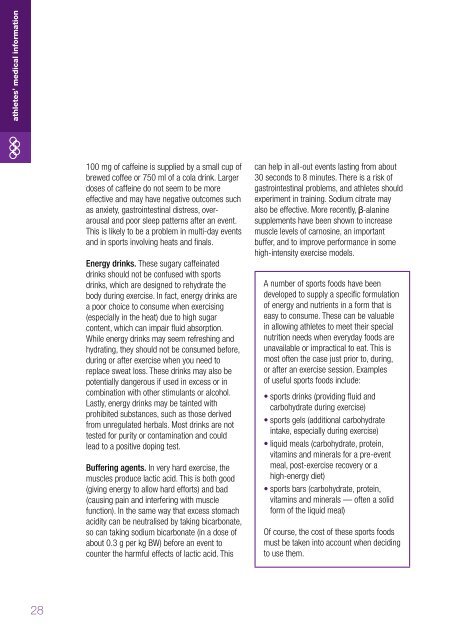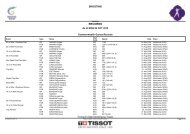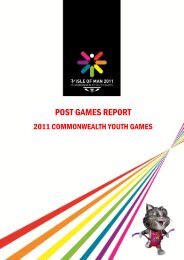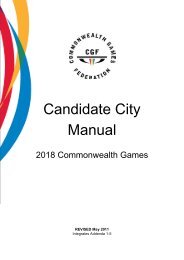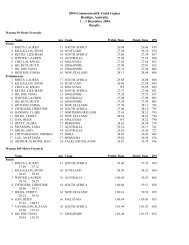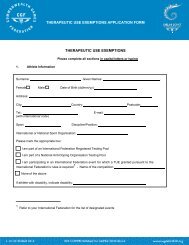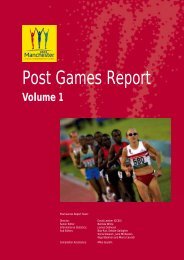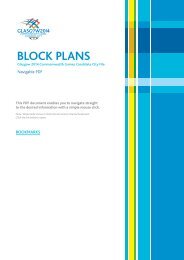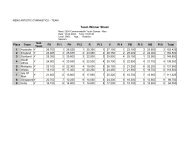Nutrition for Athletes - Commonwealth Games Federation
Nutrition for Athletes - Commonwealth Games Federation
Nutrition for Athletes - Commonwealth Games Federation
Create successful ePaper yourself
Turn your PDF publications into a flip-book with our unique Google optimized e-Paper software.
athletes’ medical in<strong>for</strong>mation100 mg of caffeine is supplied by a small cup ofbrewed coffee or 750 ml of a cola drink. Largerdoses of caffeine do not seem to be moreeffective and may have negative outcomes suchas anxiety, gastrointestinal distress, overarousaland poor sleep patterns after an event.This is likely to be a problem in multi-day eventsand in sports involving heats and finals.Energy drinks. These sugary caffeinateddrinks should not be confused with sportsdrinks, which are designed to rehydrate thebody during exercise. In fact, energy drinks area poor choice to consume when exercising(especially in the heat) due to high sugarcontent, which can impair fluid absorption.While energy drinks may seem refreshing andhydrating, they should not be consumed be<strong>for</strong>e,during or after exercise when you need toreplace sweat loss. These drinks may also bepotentially dangerous if used in excess or incombination with other stimulants or alcohol.Lastly, energy drinks may be tainted withprohibited substances, such as those derivedfrom unregulated herbals. Most drinks are nottested <strong>for</strong> purity or contamination and couldlead to a positive doping test.Buffering agents. In very hard exercise, themuscles produce lactic acid. This is both good(giving energy to allow hard ef<strong>for</strong>ts) and bad(causing pain and interfering with musclefunction). In the same way that excess stomachacidity can be neutralised by taking bicarbonate,so can taking sodium bicarbonate (in a dose ofabout 0.3 g per kg BW) be<strong>for</strong>e an event tocounter the harmful effects of lactic acid. Thiscan help in all-out events lasting from about30 seconds to 8 minutes. There is a risk ofgastrointestinal problems, and athletes shouldexperiment in training. Sodium citrate mayalso be effective. More recently, -alaninesupplements have been shown to increasemuscle levels of carnosine, an importantbuffer, and to improve per<strong>for</strong>mance in somehigh-intensity exercise models.A number of sports foods have beendeveloped to supply a specific <strong>for</strong>mulationof energy and nutrients in a <strong>for</strong>m that iseasy to consume. These can be valuablein allowing athletes to meet their specialnutrition needs when everyday foods areunavailable or impractical to eat. This ismost often the case just prior to, during,or after an exercise session. Examplesof useful sports foods include:• sports drinks (providing fluid andcarbohydrate during exercise)• sports gels (additional carbohydrateintake, especially during exercise)• liquid meals (carbohydrate, protein,vitamins and minerals <strong>for</strong> a pre-eventmeal, post-exercise recovery or ahigh-energy diet)• sports bars (carbohydrate, protein,vitamins and minerals — often a solid<strong>for</strong>m of the liquid meal)Of course, the cost of these sports foodsmust be taken into account when decidingto use them.28


